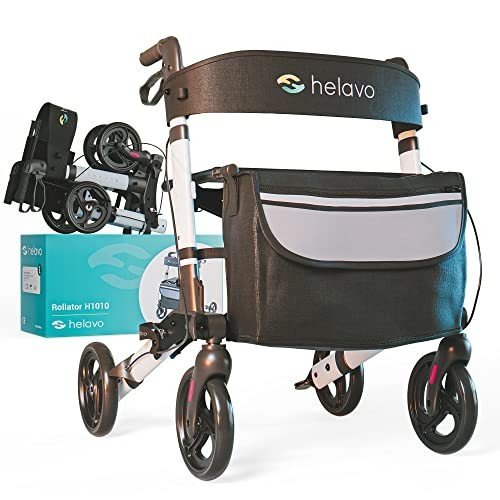
Rollator For Travel
Add a review FollowOverview
-
Founded Date October 20, 2004
-
Sectors Psychiatry doctors
-
Posted Jobs 0
-
Viewed 14
Company Description
The Companies That Are The Least Well-Known To Follow In The Senior Walker Industry

A Comprehensive Guide to Senior Walkers: Enhancing Mobility and Independence
As people age, maintaining mobility becomes vital for preserving self-reliance and lifestyle. For many seniors, walking aids such as walkers provide a valued service to assist them navigate their environment securely and with self-confidence. This article looks into the multifaceted world of senior walkers, including their types, benefits, use, and some often asked concerns.
Understanding Senior Walkers
Walkers, typically referred to as walking frames, are mobility aids designed to supply assistance and balance for people who might have problem walking independently. They generally include a sturdy frame, grips for holding, and in some cases, wheels for ease of movement. Understanding the various types of walkers offered can help seniors and their caretakers make well-informed decisions.
Types of Senior Walkers
| Walker Type | Description | Best For |
|---|---|---|
| Requirement Walker | A four-legged frame that should be raised to move on. | Seniors needing maximum stability. |
| Two-Wheeled Walker | A walker with 2 wheels on the front for much easier mobility. | Those with slight balance issues. |
| Four-Wheeled Walker | A walker with four wheels, frequently includes a seat and brakes. | Active seniors needing mobility and rest durations. |
| Rollator Walker | A type of four-wheeled walker that is lightweight and foldable. | Seniors who are more active and need slight assistance. |
| Platform Walker | A specialized walker with a platform for assistance, often utilized in physical therapy. | People needing specific support for injuries. |
Benefits of Using Senior Walkers
Senior walkers offer various benefits that substantially boost the mobility and independence of elderly individuals. Here are some of the most notable benefits:
- Increased Stability: Provides a solid base of assistance, minimizing the risk of falls.
- Boosted Confidence: Encourages motion and can reduce stress and anxiety about walking.
- Improved Posture: Helps keep an upright posture while Walking Frame.
- Social Engagement: Facilitates participation in social activities by enabling mobility.
- Therapeutic Use: Can be utilized throughout rehabilitation to enhance strength and balance.
Selecting the Right Walker
When selecting a walker, different aspects need to be thought about to guarantee the very best fit. Below are essential points seniors or caregivers should evaluate:
- Weight Capacity: Ensure the walker can support the user’s weight.
- Height Adjustability: An appropriate height change is necessary for comfort and efficiency.
- Mobility Needs: Consider the user’s specific requirements, such as level of stability needed.
- Way of life Factors: Think about where the walker will be used and how frequently.
Appropriate Use of Walkers
To optimize the benefits and reduce risks related to walkers, appropriate usage strategies are essential. Here are actions seniors need to follow:
- Stand in the Walker: Position the walker in front of them, ensuring it is stable.
- Grip the Handles: Hold the handles securely, making sure a comfy grip.
- Stroll Inside the Frame: Move forward by taking little actions, ensuring the front legs of the walker remain on the ground.
- Turn with Care: To alter direction, pivot on the feet while moving the walker.
- Use Cautiously: Avoid rushing and remember to take breaks when tired.
Regularly Asked Questions (FAQs)
What is the average price of a senior walker?
The cost of senior walkers can vary based on functions and products used. Standard walkers might cost as low as ₤ 30, while innovative designs with wheels and seats might vary from ₤ 50 to ₤ 150.
How do I figure out if my enjoyed one needs a walker?
Signs that a senior might require a walker can include regular stumbling or losing balance, a current surgery or injury impacting mobility, and avoiding walking or taking part in social activities.
Can a walker assist with rehab exercises?
Yes, walkers can be an essential part of physical therapy, assisting seniors gain back strength and dexterity through safe motion.
Where can I acquire a senior walker?
Walkers can be purchased at medical supply shops, drug stores, or online sellers. Some insurance plans might even cover part of the cost.
How do I maintain a senior walker?
Routine upkeep includes looking for loose parts, making sure brakes work correctly, and cleaning the frame to avoid rust or wear.
Senior walkers are an indispensable resource for preserving mobility and independence as one ages. With numerous types of walkers readily available, it is vital for seniors and caregivers to think about personal requirements, use, and comfort when choosing an appropriate walking aid. By motivating safe mobility, walkers not only boost physical capabilities but also positively impact social connections and psychological wellness.
Through proper usage and care, seniors can take pleasure in an active, appealing way of life, boosted by the support of their walker. Comprehending the importance of mobility aids like walkers is fundamental in promoting enhanced life quality for seniors facing mobility obstacles.







